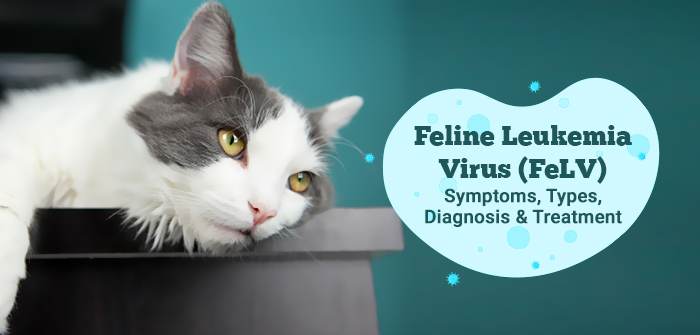Feline Leukemia Virus (FeLV) – Symptoms, Treatment & More

Feline leukemia virus (FeLV) is a cancer-causing retrovirus belonging to the Oncovirinae subfamily. This virus weakens a cat’s immune system and makes them more susceptible to illnesses. It is a life-threatening condition for cats because it can lead to cancer and death in the majority of cases.
FeLV is one of the most common infectious feline diseases, as it can be easily transmitted from one cat to another. Nonetheless, the only good part about FeLV is that it is one of the few cancers that can be prevented with vaccination.
How is Feline Leukemia Virus transmitted?
FeLV is spread through saliva, nasal secretions, urine, feces, and milk from other infected cats that are “shedding” the virus, which means the virus is reproducing in the body and being discharged into the environment. This means that cat-to-cat transmission can happen during grooming, biting, wounds, and even sharing feeding dishes and litter boxes. It can also be passed down from mother cats to their kittens while they are still in the womb or nursing.
Clinical Signs and Symptoms of Feline Leukemia Virus
FeLV has a variety of negative effects on a cat’s body. It is the most prevalent cause of cancer in cats, and it can cause blood diseases as well as immune insufficiency, which makes it difficult for a cat to defend itself against other infections. As a result, common bacteria, viruses, protozoa, and fungus that do not normally harm healthy cats can cause serious illness in FeLV-positive cats. Many of the disorders associated with FeLV are caused by secondary infections.
Cats infected with Feline Leukemia Virus may suffer from:
- Loss of appetite
- Weight loss
- Pale gums
- Fever
- Diarrhea
- Difficulty in breathing
- Weakness and lethargy
- Behavioural and neurological disorders
- Poor coat condition
- Yellowish mouth and eyes
- Eye infections
- Bladder, skin, and respiratory infections
- Reproductive problems
- Reproductive failures and sterility
Diagnosis of Feline Leukemia Virus
Feline Leukemia Virus can be diagnosed by conducting a simple blood test called ELISA (Enzyme-Linked Immunosorbent Assay). ELISA is a highly sensitive test that confirms the disease by identifying FeLV proteins in the blood. It may take up to 30 days for an infected cat to test positive.
If a cat tests positive for FeLV, your veterinarian may recommend more in-depth tests like PCR (Polymerase Chain Reaction) and IFA (Immunofluorescence Assay) to determine the further spread of the virus.
Treatment and Prevention of Feline Leukemia Virus
Unfortunately, currently, there is no known treatment for FeLV. However, supportive care can help cats with the virus enhance their quality of life, health, and lifespan. A vet will most likely treat specific symptoms displayed by an infected cat. You can minimize your cat’s stress with products like Feliway that mimic a cat’s natural calming pheromones.
The only comprehensive way to protect your cat from FeLV is to prevent it. Here are some sure-fire ways to prevent FeLV infections:
- Vaccinating the cats that are at a high risk of contracting FeLV
- Testing cats for FeLV before introducing them to your home
- Keeping cats away from potentially infected cats
- Isolating infected cats from healthy cats
- Readily taking the cat to the veterinarian when they appear sick
Bottom Line
Sorrowfully, 85% of cats infected with FeLV die within three years of infection. But a little more care and vigilance on your part can save your feline from this dreadful infection.

